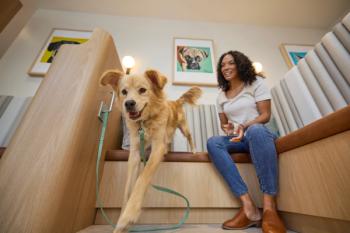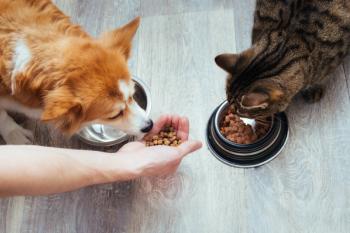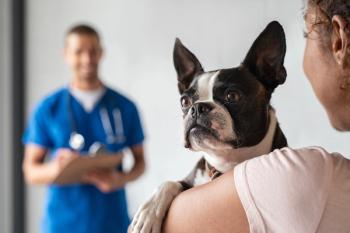
- dvm360 May-June 2025
- Volume 56
- Issue 3
- Pages: 34
Decision-making for colic workup in the field
Identifying the cause is important in determining a management plan
Colic is most often attributed to the gastrointestinal system; however, other organ systems can contribute to the general, often nonspecific clinical signs associated with colic. Owners may describe anything from lethargy or inappetence to inability to rise, and deciphering an owner’s description of clinical signs is often the first hurdle in a colic workup. The next hurdle is often deciding whether management at the farm, referral to a hospital, or euthanasia is warranted.
What can you do in your on-farm workup to decide on the best course of action for both your patient and owner? Consider the following:
Physical examination: This is the simplest part of your colic workup and can sometimes provide the most useful information for deciding what may be going on with your patient. A heart rate greater than 60 beats per minute or discolored mucous membranes, including brick red, purplish, or with a toxic line, are suggestive of surgical or severe medical colic conditions. If you are managing a patient with colic in the field, serial physical examinations can be key in understanding whether your efforts are improving the primary condition or whether referral after initial therapy on the farm may be warranted. Always remember to take a temperature prior to the administration of nonsteroidal anti-inflammatories or rectal palpation.
Nasogastric intubation and reflux: This is typically the procedure that follows physical examination during colic workup in the field. Large volumes (> 4 L) of reflux often accompany small intestinal lesions, including strangulating lesions, nonstrangulating small intestinal obstructions, or enteritis. Differentiating enteritis from obstructive lesions can be difficult, particularly with limited laboratory work on the farm; however, one hint can be how the horse behaves following relieving stomach distention—small intestinal strangulations will typically remain painful even after stomach decompression, while enteritis cases may become more comfortable but show depression or lethargy. If you obtain reflux and referral to the hospital is an option for the patient, leave the tube in place and cover the end with a 1-way valve (taping a glove finger with a hole cut in the end works great). Although this won’t always prevent a stomach from rupturing, it will at least provide a route for excess fluid to exit the stomach while en route.
Rectal palpation: Some gastrointestinal lesions have very classical rectal exam findings, while other times you can identify that something doesn’t feel right but may not be able to definitively decide what you are feeling. Some rectal exam findings that suggest referral or euthanasia include distended small intestine, which often feels like loops of balloon animals or sausage, or a severely distended large colon. It isn’t uncommon for colon torsions to present with colon gas distention severe enough to prevent the ability to perform a rectal palpation.
Other diagnostics that are often overlooked on the farm but can help with decision-making in euthanasia, referral, or on-farm management can include abdominocentesis or fast localized abdominal sonography (FLASH) ultrasound.
Abdominocentesis: For most horses, all that is needed is a 1.5-in 18-g needle, sterile gloves, and a red top blood tube. Abdominocentesis is typically performed at the lowest point of the abdomen when looking at the horse from the side, directly on midline. An area should be clipped and aseptically prepared in standard fashion.
This author typically will perform abdominocentesis with the patient lightly sedated but does not routinely locally anesthetize the site when using a needle for sampling; however, a small amount of local anesthetic can be injected into the proposed site. Following aseptic preparation and donning sterile gloves, the abdominocentesis can be performed. This author typically uses a 1.5-in 18-g needle—for an average-sized horse, holding the needle halfway for the initial stick will embed enough of the needle that it won’t dislodge easily if the horse moves but will not typically be deep enough to enter the abdomen.
This author will stick quickly on midline up to where the needle is held, ready to move if the patient kicks or otherwise objects (however, most lightly sedated horses do not respond). Once the needle is seeded in the abdominal wall, it should be slowly (1-2 mm at a time) advanced until it is within the peritoneal cavity. With slow advancement you can typically see movement of the needle as the intestine shifts around it (often a ticking or rocking of the needle not associated with respiration)—at this point the needle may need to be advanced slightly further but is very close or within the peritoneal cavity. If no fluid is obtained, the needle should be spun to move the bevel in relation to the omentum and viscera. If still no fluid is present, a sterile, empty 5-mL syringe can be used to push a small amount of air into the abdomen through the needle: This may help to push omentum off the needle or start a siphon to encourage fluid to exit the needle. Once fluid is noted in the hub, it can be caught using the blood tube with the stopper removed. Once fluid is obtained, the needle can simply be removed.
Even without additional equipment, the color and turbidity of the fluid can provide keen insight into the lesion present in the abdomen. Normal abdominal fluid should be straw-colored and clear (Figure 1a). Turbidity of the fluid typically suggests increased cellularity. Strangulating lesions result in leakage of cells from the vasculature, creating serosanguinous abdominal fluid (Figure 1b). Frank blood may be suggestive of a hemoabdomen or, more likely, splenic sampling. Additionally, grossly brown or green fluid with or without feed material may indicate viscera rupture or enterocentesis. For both situations, a second abdominocentesis should be performed before drastic measures, such as euthanasia, are performed to confirm findings. If you see colic cases frequently, a handheld lactometer can be extremely helpful in deciding referral or euthanasia—an abdominal fluid lactate greater than the systemic lactate occurs with strangulating lesions but may take a bit of time to increase in the abdominal fluid; many practitioners view an abdominocentesis to blood lactate ratio greater than 2 as highly suggestive of a strangulation.1
FLASH ultrasound: FLASH ultrasound can be performed in 10 to 15 minutes and can provide considerable information regarding potential causes for colic and greatly aid in the decision to refer or euthanize. This procedure is well described in literature and provides an excellent overview of the locations and possible findings.2 Horses with small intestinal lesions, be they medical or surgical, often show loops of dilated small intestine. Motility of dilated small intestinal loops can be assessed in real time, with nonmotile intestine often showing sedimentation of ingesta, identified as an echoic layer within a loop of distended and fluid-filled small intestine (Figure 2). Strangulating small intestinal lesions typically will have several different populations of intestine, including dilated with a normal wall thickness (intestine orad to the obstruction), dilated with thickened wall (the strangulated portion), or empty (intestine aborad to the obstruction). Enteritis may also have thickened wall, but often it is not as thick as strangulating lesions and often is more diffuse compared with the distinct populations present in strangulating lesions. Colon volvulus cases can also develop colon wall thickening, as can colitis (Figure 3). Horses with colon displacement or volvulus may have colonic blood vessels, which can be visualized on ultrasound because of movement of the vasculature from the axial aspect of the colon to a site closer to the skin and superficial to any gas shadowing from the colon lumen.3 Additional findings that may be helpful include evidence of stomach dilation, increased free abdominal fluid, and presence of viscera in the nephrosplenic space.
Decision tree for farm management vs referral vs euthanasia
The decision for on-farm management, referral for more intensive medical management or surgery, or immediate euthanasia is a decision that needs to be made based on workup findings, patient factors, and owner wishes. Rapid referral for surgical conditions or severe medical colics improves prognosis. However, there are times, such as if rupture has already occurred or situations where clinic management is necessary and not an option for the patient, where euthanasia on the farm will reduce additional suffering for the patient. Being able to discuss options with your owner, including approximate costs, potential therapy, and ballpark prognosis can aid them in making an informed decision regarding their horse’s care.
Figure 4 shows some of the most common causes of equine colic and this author’s suggestions for management. Keep in mind that many listed in the on-farm management category may be better managed in a clinic setting, and referral instead of on-farm management is never a bad idea. Additionally, if referral isn’t an option, there will be a line between when horses refractory to on-farm treatment may warrant euthanasia—for example, impactions that have been managed for several days without improvement on rectal palpation or increasing pain or systemic compromise. These cases need to be assessed frequently and discussions between the owner and veterinarian continued to give the patient their best chance at colic resolution, but not causing undue suffering if on-farm management is going to be unsuccessful in the end.
Helping your patient and your client
At the end of your colic workup, you need to decide, along with the owner, the best course of action for your patient. Although a large portion of this decision will be based on your colic workup, cost and logistics also play a role in large animal veterinary medicine. One tool that can be very helpful in the decision-making process for your owner is being able to give them some estimates if a referral for medical management or surgery may be pursued. Most referral facilities can provide an idea of approximate costs for colic workup in the hospital or average colic surgery costs given the findings on your exam.
Evaluation on the farm of patients with colic is the first step in successful management of the acute crisis. Thorough evaluation on the farm and prompt referral for cases requiring additional care can contribute considerably to the overall prognosis for your patient.
Erica Secor, DVM, MS, DACVS-LA, is an American College of Veterinary Surgeons–boarded large animal surgeon and currently working on a PhD in biomedical and biological sciences at Cornell University in Ithaca, New York. In addition to clinical and research work, Secor enjoys trail running, baking, and enjoying time in the woods with her husband, son, and Morgan gelding.
REFERENCES
- Radcliffe RM, Liu SY, Cook VL, Hurcombe SDA, Divers TJ. Interpreting abdominal fluid in colic horses: understanding and applying peritoneal fluid evidence. J Vet Emerg Crit Care (San Antonio). 2022;32(S1):81-96. doi:10.1111/vec.13117
- Busoni V, De Busscher V, Lopez D, Verwilghen D, Cassart D. Evaluation of a protocol for fast localized abdominal sonography of horses (FLASH) admitted for colic. Vet J. 2011;188(1):77-82. doi:10.1016/j.tvjl.2010.02.017
- Manso-Díaz G, Bolt DM, López-Sanromán J. Ultrasonographic visualization of the mesenteric vasculature in horses with large colon colic. Vet Rec. 2020;186(15):491. doi:10.1136/vr.105468
Articles in this issue
5 months ago
Renovate to revitalize5 months ago
Overcoming understaffing5 months ago
When clients lie about preventive dosingNewsletter
From exam room tips to practice management insights, get trusted veterinary news delivered straight to your inbox—subscribe to dvm360.






